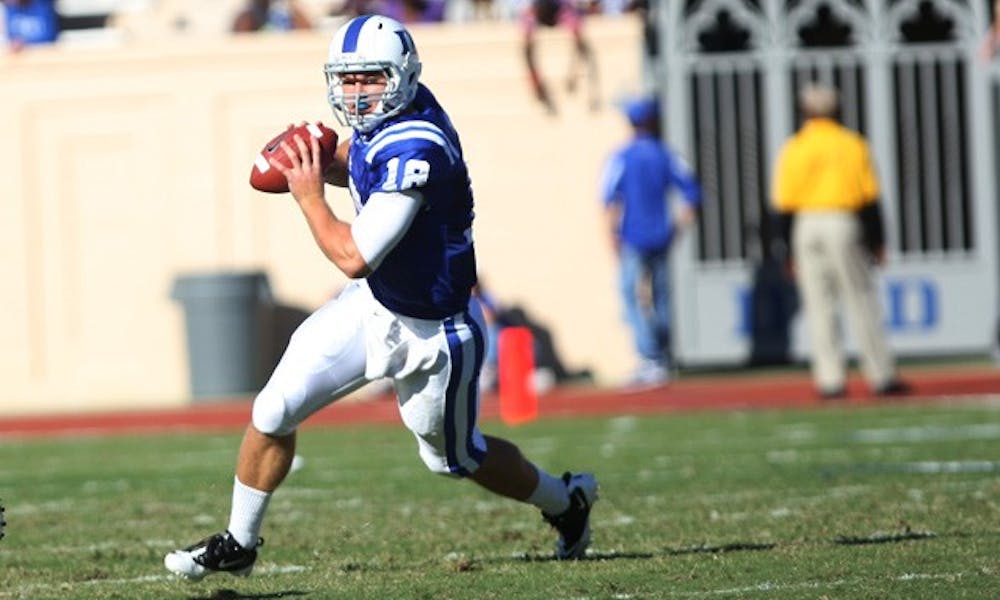“It’s not a two-quarterback system,” head coach David Cutcliffe said at his press conference Tuesday. “It’s playing your backup. There’s a difference.”
While Cutcliffe would go on to clarify his comments, I find his message to be confusing and misleading. He is willing to discuss the value in playing two quarterbacks, but refuses to call it a two-quarterback system, instead referring to it as a two-offense system.
“When you have a two-quarterback system, that usually means you don’t have one [good quarterback],” Cutcliffe continued. “Playing your backup means you have confidence in him. We’re more of a two-offense system.”
Debating semantics aside, I am forced to seriously question whether or not trying to rotate two quarterbacks in and out of the game is best for the Duke offense’s overall productivity. Cutcliffe was quick to point out that he has experience when it comes to balancing the talents of dual quarterbacks. Bear Bryant, the legendary Alabama coach and one of Cutcliffe’s early mentors, was a big proponent of using multiple signal-callers, though mainly in a rushing capacity. And, at Ole Miss, Cutcliffe rotated through quarterbacks as he tried to find the passer with the hottest hand.
Beyond Cutcliffe’s personal coaching history, though, I wanted to scan the college football landscape to look for more recent evidence of other successful two-quarterback systems.
BYU was one program steadfast in its reliance on a dual-quarterback system early this season. But after Jake Heaps and Riley Nelson both struggled to establish a rhythm and the team suffered, Heaps became the starter, and BYU has won four of its last five.
Michigan has also given extensive snaps to both Denard Robinson and Tate Forcier this year, mainly due to Robinson’s injury troubles. Both quarterbacks have had good seasons but also have been inconsistent at times, and the program’s up-and-down season mirrors the situation under center.
Mississippi State and LSU have also run out multiple quarterbacks this year. While both are near the top of the SEC, it might be despite their quarterback play. They both have been looking for answers at quarterback and continue to waffle between options.
My point is not that a team can’t have a successful season while using two passers, but that the most dominant teams of each season do not feature a revolving door at quarterback. Typically, rotation is a result of inconsistency and discontent. The one recent exception to this rule would be the Chris Leak-Tim Tebow combination that led Florida to a national championship in 2006. However, guys like Tebow that go down amongst the most dominant players in college football history are exceptions, and even he saw limited reps his freshman season.
Looking specifically at the Blue Devils, the emergence of Brandon Connette’s role in the offense coincided with Sean Renfree’s midseason struggles and the inefficiency of the offense in the red zone against Maryland.
Initially, Connette’s snaps were limited to almost exclusively red zone possessions. He even took the game’s first snap against Miami since Duke started inside the Miami 10. For the most part, the true freshman rewarded the coaching staff by improving red zone efficiency on the power of his legs.
However, it was very troubling in last week’s loss to Boston College when the running specialist began taking snaps in all areas of the field. With Sean Renfree developing a rhythm down the season’s stretch run, losing snaps becomes problematic.
“I really don’t know to be honest,” Renfree told me with regard to the substitution pattern. “It could be first-and-10 or third-and-short. I don’t know when they are going to be putting him in.”
Despite his increased action, only two of the 10 plays on which Connette ran or threw against the Eagles resulted in a positive result, and all of his red zone possessions stalled, with the drives ending in field goals.
Ironically, both the positive plays were actually short gains via the pass. The problem was that it has become pretty apparent that Connette is on the field to run, and the Eagles’ defense stacked the box, daring him to pass. Not a bad strategy against a guy who has only thrown 20 passes in his young career.
While both quarterbacks are publicly supportive of their shared roles, no Division I athlete wants to leave the field. And, right now, Connette isn’t nearly polished enough as a passer to force defenses to respect his throwing ability. And this element of surprise and variability is needed for the Wildcat-like system Cutcliffe is using to add another wrinkle to Duke’s offensive attack.
“In today’s changing game, we want to become harder to defend and have more options,” Cutcliffe said.
Regardless, Cutcliffe and Connette haven’t conviced me. The most potent offenses rely on personnel consistency, a consistency absent in Durham.
Get The Chronicle straight to your inbox
Signup for our weekly newsletter. Cancel at any time.

